Kdo chodil s Catherine II?
Alexander Yermolov datováno Catherine II od ? do ?.
Ivan Nikolajevič Rimskij-Korsakov datováno Catherine II od ? do ?. Věkový rozdíl byl 24 roky, 8 měsíců a 22 dny.
Alexander Dmitriev-Mamonov datováno Catherine II od ? do ?. Věkový rozdíl byl 29 roky, 4 měsíců a 28 dny.
Aleksandr Dmitrijevič Lanskoj datováno Catherine II od ? do ?. Věkový rozdíl byl 28 roky, 10 měsíců a 6 dny.
Sergej Vasiljevič Saltykov datováno Catherine II od ? do ?.
Pyotr Zavadovsky datováno Catherine II od ? do ?. Věkový rozdíl byl 9 roky, 8 měsíců a 19 dny.
Semyon Zorich datováno Catherine II od ? do ?.
Alexander Vasilchikov datováno Catherine II od ? do ?.
Platon Zubov datováno Catherine II od ? do ?. Věkový rozdíl byl 38 roky, 6 měsíců a 24 dny.
Gregory Potyomkin datováno Catherine II od ? do ?. Věkový rozdíl byl 10 roky, 4 měsíců a 22 dny.
Grigorij Grigorjevič Orlov datováno Catherine II od ? do ?. Věkový rozdíl byl 5 roky, 5 měsíců a 15 dny.
Stanisław August Poniatowski datováno Catherine II od ? do ?. Věkový rozdíl byl 2 roky, 8 měsíců a 15 dny.
Catherine II

Catherine II (en russe : Екатерина II) ou Catherine la Grande (Екатери́на Вели́кая), née Sophie Frédérique Augusta d'Anhalt-Zerbst le 2 mai 1729 à Stettin en Poméranie (aujourd'hui Szczecin en Pologne) et morte le 17 novembre 1796 à Saint-Pétersbourg, est l'épouse du prince puis empereur Pierre III (1728-1762). Elle devient impératrice régnante de Russie en 1762 jusqu'à sa mort, à la suite d'un coup d'État le 9 juillet 1762, suivi de l'incarcération de Pierre III, puis de son exécution le 17 juillet par un proche de Catherine.
Prénommée Catherine lors de son baptême orthodoxe, nécessaire avant son mariage avec le prince Pierre, elle devient impératrice consort après l'avènement de celui-ci (5 janvier 1762). Après son coup d'État, elle se fait proclamer « impératrice et autocrate de toutes les Russies ».
Elle règne personnellement sur l'Empire russe du 9 juillet 1762 à sa mort le 17 novembre 1796. Sous son règne, la Russie connaît une grande expansion territoriale vers l'ouest et le sud (plus de 500 000 km2), notamment à l'occasion des trois partages de la Pologne (1772, 1793 et 1795) et de guerres victorieuses contre l'Empire ottoman.
Přečtěte si více...Alexander Yermolov

Alexander Petrovich Yermolov (1754–1834) was a Russian favourite and the lover of Catherine the Great from 1785 to 1786.
Yermolov was presented to Catherine by Grigory Potemkin, tested by Anna Protasova and became Catherine's lover in 1785. He collaborated with the enemies of Potemkin and attempted to have Potemkin removed, and thereby lost his position. He went to Paris in the late 1780s and spent the rest of his life in Schloss Frohsdorf.
Přečtěte si více...Catherine II

Ivan Nikolajevič Rimskij-Korsakov

Ivan Nikolajevich Rimsky-Korsakov, né Korsav (29 June 1754 – 31 July 1831 in Saint Petersburg, Russian Empire) was a Russian courtier and lover of Catherine the Great from 1778 to 1779.
Přečtěte si více...Catherine II

Alexander Dmitriev-Mamonov

Il conte Aleksandr Matveevič Dmitriev-Mamonov (in russo Александр Матвеевич Дмитриев-Мамонов?; Smolensk, 30 settembre 1758 – San Pietroburgo, 11 ottobre 1803) è stato un diplomatico russo, appartenente ad un'antichissima dinastia della nobiltà dei boiardi discendente dei Rurichidi e con grandi possedimenti nei pressi di Smolensk.
In quanto aiutante di campo del conte Potemkin, Mamonov nel 1784 fu presentato alla zarina Caterina II, della quale in breve divenne il favorito.
Grazie al favore dell'imperatrice, che gli tributava 100.000 fiorini annui, riuscì ad istituire una piccola corte di illuministi, che tra gli altri comprendeva il conte Semën Romanovič Voroncov, Nikolaj Aleksandrovič Zubov, fratello di Platon Aleksandrovič Zubov, Pëtr Alekseevič Palen, José de Ribas, Aleksandr Andreevič Bezborodko e Nikita Petrovič Panin e inoltre Mamonov tenne un frequente scambio epistolare con il mecenate di Wolfgang Amadeus Mozart, Friedrich Melchior von Grimm.
Nel 1787 prese parte ai negoziati con Stanislao II Augusto Poniatowski e Giuseppe II d'Austria, divenendo Reichsgraf ("conte del Sacro romano impero"). Alla sua morte fu inumato nel Monastero di Donskoj.
Přečtěte si více...Catherine II

Aleksandr Dmitrijevič Lanskoj
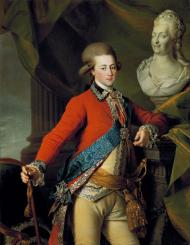
Alexander Dmitrievich Lanskoy, also called Sashin'ka or Sasha, (19 March [O.S. 8 March] 1758 – 6 July [O.S. 25 June] 1784) was a Russian general, favourite and lover of Catherine the Great between 1780 and 1784. It has been said that "[a] look at [her] correspondence with her favorites gives the impression she only had tender feelings for one, Alexander Lanskoi."
Přečtěte si více...Catherine II

Sergej Vasiljevič Saltykov

Count Sergei Vasilievich Saltykov (Russian: Сергей Васильевич Салтыков, IPA: [sʲɪrˈɡʲej vɐˈsʲilʲjɪvʲɪtɕ səltɨˈkof]; c. 1722 – 1784) was a Russian officer (chamberlain) who became the first lover of Empress Catherine the Great after her arrival in Russia.
Přečtěte si více...Catherine II

Pyotr Zavadovsky
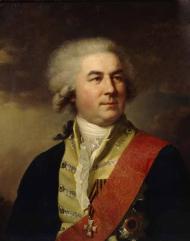
Pyotr Zavadovsky (1739–1812) was a Russian statesman of Ukrainian origin. He was a favourite (lover) of Russian empress Catherine the Great from 1776 to 1777.
Přečtěte si více...Catherine II

Semyon Zorich
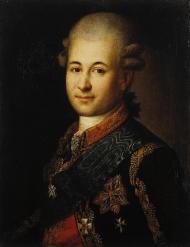
Count Semyon Zorich (1743–1799) was a Serbian-born Russian lieutenant-general and count of the Holy Roman Empire. He served Russia against the Prussians and Turks. A member of the Russian court, he was presented to Empress Catherine the Great by Grigory Potemkin and, after having been tested by Praskovja Bruce and doctor Rogerson, became the Empress' lover. He was most influential in the commercial development of Shklov and Mogilev.
Přečtěte si více...Catherine II

Alexander Vasilchikov

Alexander Semyonovich Vasilchikov (Russian: Александр Семёнович Васильчиков, tr. Aleksandr Semënovič Vasil'čikov; 1746–1813) was a Russian aristocrat who became the lover of Catherine the Great from 1772 to 1774.
Vasilchikov was an ensign in the Chevalier Guard Regiment when he was noted by Catherine and was appointed gentleman of the bedchamber on 1 August 1772. When Catherine's then-lover Grigory Grigoryevich Orlov left court, Catherine was informed about his adultery, and 12 August, Vasilchikov was made general aide-de-camp and lover of Catherine. Vasilchikov was expected to be available to attend on her at all times, and was not allowed to leave the palace without permission.
The relationship was short-lived. Catherine found Vasilchikov's gentleness cloying, saying "His tenderness made me weep." When Vasilchikov was away on a journey, sent by the empress, Grigory Potemkin replaced him as her lover. She wrote to her friend Friedrich Melchior, Baron von Grimm about Vasilchikov's dismissal: "Why do you reproach me because I dismiss a well-meaning but extremely boring bourgeois in favour of one of the greatest, the most comical and amusing, characters of this iron century?"
Vasilchikov later complained that he felt like a hired gigolo: "I was nothing more to her than a kind of male cocotte and I was treated as such. If I made a request for myself or anyone else, she did not reply, but the next day I found a bank-note for several thousand rubles in my pocket. She never condescended to discuss with me any matters that lay close to my heart."
Catherine characteristically rewarded her former lover richly. Vasilchikov was given a pension of twenty thousand rubles and valuable properties. He lived the rest of his life in Moscow. He never married. He built a notable collection of Western European paintings and sculptures, including a "Self Portrait" by Velasquez and works by Philips Wouwerman and Andries Botha.
Přečtěte si více...Catherine II

Platon Zubov
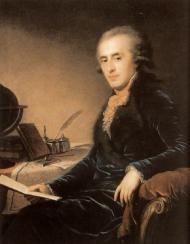
Platon Alexandrovič Zubov (rusky Платон Александрович Зубов; 15. listopadujul./ 26. listopadu 1767greg., Vladimir – 7. dubnajul./ 19. dubna 1822greg., Rundāle, Kuronsko) byl ruský šlechtic a politik, od roku 1789 milenec a favorit carevny Kateřiny Veliké, jeden z vrahů cara Pavla I.
Přečtěte si více...Catherine II

Gregory Potyomkin

Grigorij Alexandrovič Potěmkin-Tavričeskij, správným přepisem Poťomkin-Tavričeskij, (rusky Григорий Александрович Потёмкин-Таврический; 13. záříjul./ 24. září 1739greg., Čiževo – 5. říjnajul./ 16. října 1791greg., Jasy) byl ruský šlechtic, voják, diplomat a politik, který vstoupil do dějin především jako dlouholetý rádce, milenec a neoficiální spoluvládce carevny Kateřiny II. Veliké.
Přečtěte si více...Catherine II

Grigorij Grigorjevič Orlov
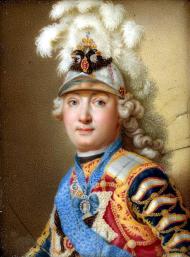
Prince Grigory Grigoryevich Orlov (Russian: Григорий Григорьевич Орлов; 17 October 1734 – 24 April 1783) was a favourite of the Empress Catherine the Great of Russia, Prince of the Holy Roman Empire (1772), state and military figure, collector, patron of arts, and General-in-Chief.
He patronised M. V. Lomonosov, D. I. Fonvisin, V. I. Bazhenov and gave them financial support. Honorary member of the Imperial Academy of Arts (since 1765). He collected paintings (including Rembrandt, P. P. Rubens, Titian), sculpture, Chinese, Japanese and Russian porcelain, hunting weapons, etc. (Orlov's collection has been preserved almost completely; it is now in the State Museum-Reserve "Gatchina" of the eponymous city). A large landowner, particularly of the Gatchina manor, where Orlov commissioned the construction of a palace and a landscape garden.
He became a leader of the 1762 coup which overthrew Catherine's husband Peter III of Russia and installed Catherine as empress. For some years he was virtually co-ruler with her, but his repeated infidelities and the enmity of Catherine's other advisers led to his fall from power.
Přečtěte si více...Catherine II

Stanisław August Poniatowski
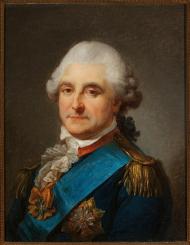
Stanisław August Poniatowski, jako král Stanislav II. (17. ledna 1732 Wołczyn, dnes v Brestské oblasti v Bělorusku – 12. února 1798 Petrohrad, Rusko), byl polský král v letech 1764–1795. Za jeho vlády došlo k postupnému rozdělení Polska mezi okolní mocnosti, až do jeho úplného zániku.
Narodil se do zámožné rodiny. Byl synem hraběte Stanislava Poniatowského a Konstancje Czartoryské. Do roku 1764 působil jako diplomat. V roce 1764 se souhlasem ruské imperátorky Kateřiny II. Veliké byl pomocí polského sněmu zvolen králem Polska. Jeho předchůdcem byl velkokníže litevský a saský kurfiřt August III. Polský. Rozhodující krizí Stanisławovy vlády byla barská konfederace, která vedla k prvnímu rozdělení Polska, ke kterému došlo v roce 1772.
Za svůj život měl celkem 3 děti (2 syny a 1 dceru). Zemřel 12. února roku 1798, dva a půl roku po své abdikaci. Příčinou smrti byla mrtvice. Jeho tělo bylo pohřbeno v kostele v Petrohradě. Od roku 1990 se jeho ostatky nachází v katedrále ve Varšavě.
Jedná se o jednu z nejkontroverznějších postav polské historie.
Přečtěte si více...